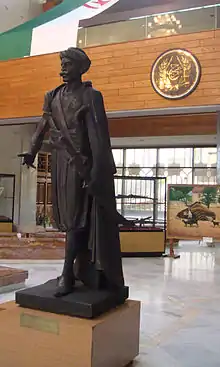Raïs Hamidou
Hamidou ben Ali , known as Raïs Hamidou (Arabic: الرايس حميدو), or Amidon in American literature, born around 1770 in Algiers, and died on June 17, 1815 near Cape Gata, was an Algerian privateer. He captured up to 200 ships during his career.[1] Hamidou ensured the prosperity of the Deylik of Algiers, and gave it its last glory before the French invasion. His biography is relatively well known because the French archivist Albert Devoulx has found important documents, including a precious register of prizes opened by the authorities of the Deylik in 1765. Songs and legends have also taken hold of this charismatic character.
Raïs Hamidou ben Ali | |
|---|---|
رايس حميدو بن علي | |
 Statue of Hamidou in the Central museum of the Army in Algiers | |
| Born | 1770 |
| Died | 1815 Cape Gata, Near of Spain |
| Resting place | Mediterranean sea |
| Nationality | Algerian |
| Piratical career | |
| Nickname | Amir el bihar (leader of the seas) |
| Other names | Amidon Hamuda |
| Type | Corsair |
| Allegiance | Deylik of Algiers |
| Years active | 1795 - 1815 |
| Rank | Captain, then Admiral |
| Base of operations | Oran, Algiers |
| Commands | Meshuda Portuguesa |
| Battles/wars | Algerian-Tunisian naval war (1811) Second Barbary War |
Origins
He was the son of Ali,[2] an artisan tailor.[3]
According to documents discovered by the archivist Albert Devoulx, Hamidou "belonged to a class of Arabs settled in the cities for a more or less long time, which the Europeans called Moors".[4] Nevertheless, he was Kabyle according to testimonies collected later from his own officers.[5] He is also described as a “native Algerian” by European sources,[6] further proving that unlike many of his counterparts, he was neither Turkish or Kouloughli.
At age 10 he gave up the tailor trade to work aboard a pirate ship commanded by Raïs Memmou. There he learned many different things, and he gained much experience from it.[7]
Beginning of his career
There are no documents on the activity of Raïs Hamidou during the first years of his functions as a pirate captain in Algiers, but we can assume that he was under the tutelage of an older privateer, and that he was doing his apprenticeship.[8]
Death.
He died in 1815 after being ambushed by an American fleet.
References
- BEAUCARNOT, Jean-Louis; DUMOULIN, Frédéric (2015-06-11). Dictionnaire étonnant des célébrités (in French). edi8. ISBN 978-2-7540-7767-5.
- Devoulx et al. 1859, p. 17.
- Devoulx et al. 1859, p. 25.
- Devoulx et al. 1859, p. 16.
- Leiner, Frederick C. (2006). The End of Barbary Terror: America's 1815 War Against the Pirates of North Africa. Oxford University Press. ISBN 978-0-19-532540-9.
- Leiner, Frederick C. (2006-05-01). The End of Barbary Terror: America's 1815 War against the Pirates of North Africa. Oxford University Press. ISBN 978-0-19-804095-8.
- Havu, Eva (1996). De l'emploi du subjonctif passé (in French). Suomalainen Tiedeakatemia. ISBN 978-951-41-0818-1.
- Rais Hamidou: Le dernier corsaire barbaresque d'Alger (2007); p. 13.
Sources
- John de Courcy Ireland (1974), "Raïs Hamidou: The Last of the Great Algerian Corsairs", The Mariner’s Mirror, 60(2), 187–196.
- Albert Devoulx, Le raïs Hamidou: notice biographique sur le plus célèbre corsaire algérien du XIIIe siècle de l'hégire, Dubos Frères, 1859
- Paul Desprès, Raïs Hamidou : Le dernier corsaire barbaresque d'Alger, Harmattan, mars 2007
- H. D. de Grammont, Histoire d'Alger sous la domination turque, Paris 1887
